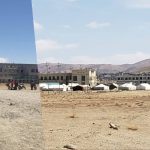Kathmandu: Nepal is one of the most prominent actors in India’s Neighbourhood First policy. Cultural affinity, geographical proximity, and civilizational continuity are the main impetus for this relationship. Nepal-India’s open border and India, being Nepal’s largest trade partner, give us a glimpse of the robustness of the ties.
In recent decades, it has been reflected in India’s aid policy towards Nepal, which specifically clubs with the World Trade Organisation’s ‘aid for trade’ initiative, which enhances the trade capabilities and economic resilience of developing and least developed countries. In this initiative, the aid is used to empower the aid receiver’s economic resilience.
In India’s 2024-25 budget allocation, Nepal received 7 billion Indian rupees (11 billion Nepali rupees). This increased from the previous year when Nepal received 5.5 billion Indian rupees (8.8 billion Nepali rupees). Large chunks of these grants have been given to South Asian countries, namely, Bhutan, Maldives, Bangladesh, and Myanmar.
Nepal also comes central to China’s foreign policy in expanding its influence in South Asia. China’s Belt and Road Initiative started in 2013 and has become central to its foreign influence. In Nepal, China has also invested money through multiple channels.
According to the Government of Nepal, Ministry of Finance, Aid Management and Information System, ‘Over the last five-year period from FY 2016/17 to FY 2020/21, a total of US$ 380.45 million of aid was disbursed to Nepal by China. The volume of disbursement was the highest in fiscal year 2018/19 totalling US$ 150.37 million than the annual average disbursement of the five years.’
In this case, it is essential to analyze how the grants and loans used by China and India in Nepal have performed for Nepal’s development.
India’s Aid to Nepal
If we take the data from the last ten years from the financial year 2013-14, Nepal has been one of the highest recipients of India’s aid. In 2013-14, it received 380 crore Indian rupees. It was high time for Nepal as it slowly transitioned into a democracy. For 2013-14, the focus was specifically on education, health and infrastructure.
In 2014-15, 2015-16 and 2016-17, Nepal received 420, 320, and 472 crores of Indian rupees respectively. During this time, it had suffered one of the most disastrous earthquakes in decades, and the support mainly went to cross-border connectivity, redevelopment of infrastructure, and disaster relief and reconstruction projects.
In the next three financial years, 2017-18, 2018-19, and 2019-20, there was a consistent flow in the amount of money, with Nepal getting 448, 472, and 744 crore Indian rupees, respectively. This money is primarily for sustainable development goals identified by the United Nations, infrastructure, health, education, and development projects.
In 2020-21, the aid decreased due to the coronavirus pandemic, and Nepal received about 576 crore Indian rupees. It again increased in the financial year 2021-22, and Nepal received 7.13 billion rupees. The financial year 2022-23 remains the year where Nepal received a lesser amount of about 4.5 billion Indian rupees, which was initially pledged at around 7.50 billion.
This money has been strategically used in a balanced way, partly for infrastructure development and partly for human resource development. Infrastructure projects mainly include the Arun III project for energy security development of roads in the Terai area, which helps mobility within Nepal and between Nepal and India.
Nevertheless, a large chunk of this aid also goes to human resource-centered areas such as healthcare. India has provided aid for creating new medical colleges and hospitals, such as BP Koirala Institute of Health Sciences. The aid enables the training of healthcare professionals in Nepal and provides jobs. Aid has also been used to upgrade educational institutes and create vocational training centers benefitting the youth and women of Nepal.
Comrades’ Obsession with BRI and Possible Risk of Debt Trap
China’s aid to Nepal
As per the data available from Nepal’s Ministry of Finance, China gave around 41 million US Dollars to Nepal in 2016-17. In 2017-18, it has given around 58 million US Dollars. In 2018-19, the amount increased by 150 million US Dollars. In 2019-20, Nepal received 93 million US dollars, and as per the last available during the coronavirus period, China provided only 37 million US Dollars to Nepal. These aids include grants, interest-free loans, and concessional loans.
According to Nepal’s Ministry of Finance, China has undertaken the infrastructure development sector as its focus area in Nepal’s development, including energy development (making hydropower plants), economic and technical cooperation, air transportation, reconstruction, and emergency COVID-19 support. In 2019-20, Chinese support mainly went for air transportation, while in 2020/21 (COVID-19), energy was its top priority.
However, China has not made much progress in this regard, as one statement by China unilaterally claimed that Pokhara International Airport was built under the BRI. Nepal’s Foreign Minister NP Saud clarified to the Nepali parliament that “not a single project in Nepal under BRI has been executed”. It is frustrating for Nepal and China both for different reasons that no project was being able to complete in the given timeline. Despite the delay, it was frustrating for Nepal because the non-viability of any financial commitment would hurt it more.
India and China’s Aid in Comparative Perspective
If we compare the GDP to the grant ratio of both India and China, India, with 3.42 trillion US dollars in GDP, has constantly supported Nepal more in relative terms of its GDP. Whereas, China, with 17.73 trillion dollars in GDP, has given lesser aid to Nepal in relative terms of its GDP.
India’s support has proven to provide more returns as it has invested mainly in human-centered projects, including making schools accessible, roads, and medical colleges. Chinese aid and other development assistance have mainly developed significant infrastructure projects with their conditionalities and require a larger timeline to get them economically viable.
In the meantime, on the one hand, it is clear that China can provide more aid to Nepal if it wants, and it may not necessarily be in the form of a concessional loan but a full-fledged grant like the United States of America’s Millennium Challenge Corporation’s (MCC) Grant. On the other hand, India can focus on developing human resources by creating a pool of Nepali professionals who can work in both the Nepali and Indian job markets.
*Harsh Pandey is a PhD Researcher at the School of International Studies, Jawaharlal Nehru University, and a life member of the International Centre for Peace Studies, New Delhi











